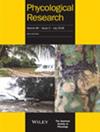恒化培养在大藻(褐藻科)和大藻(紫藻科)对营养物吸收率测定中的应用
IF 1
4区 生物学
Q2 MARINE & FRESHWATER BIOLOGY
引用次数: 0
摘要
在本研究中,我们首次应用恒化器培养方法来测量大型藻类的营养吸收率。通过比较恒化培养和分批培养的营养吸收动力学,我们研究了两种测量大型藻类(日本糖精和澳大利亚Ulva)营养吸收率的方法。在恒化器培养中,通过使用自动分析仪实时监测营养素浓度的变化并添加营养素来补偿大型藻类的营养素消耗,从而保持营养素浓度恒定。恒化器培养中的营养吸收可能最符合Michaelis–Menten饱和动力学。在分批培养中,由于大型藻类快速吸收营养物质,营养物质浓度随时间不断或呈指数下降。分批培养中的养分吸收率通常与养分浓度呈分散关系,与Michaelis–Menten饱和动力学拟合较弱。这种差异似乎部分是因为在分批培养的采样间隔之间营养物浓度的变化很大。除非实时测量营养物浓度,否则很难确定可检测浓度变化的适当采样间隔。因此,将恒化器培养方法应用于大型藻类吸收速率的测量,可以大大提高我们对养分吸收动力学的理解。本文章由计算机程序翻译,如有差异,请以英文原文为准。
Application of chemostat culture to nutrient uptake rate measurements by the macroalgae Saccharina japonica var. religiosa (Phaeophyceae) and Ulva australis (Ulvophyceae)
In this study, we applied a chemostat culture method, for the first time, to measure the nutrient uptake rate of macroalgae. We examined two methods of measuring the nutrient uptake rate of two macroalgae, Saccharina japonica var. religiosa and Ulva australis, by comparing nutrient uptake kinetics between the chemostat culture and batch culture. In the chemostat culture, the nutrient concentration was kept constant by monitoring the change in nutrient concentration using an Auto Analyzer in real time and adding nutrients to compensate for the macroalgae's nutrient consumption. The nutrient uptake in the chemostat culture could be best fitted to the Michaelis–Menten saturation kinetics. In the batch culture, the nutrient concentration decreased with time, either constantly or exponentially due to a rapid uptake of nutrients by the macroalgae. The nutrient uptake rate in the batch culture generally showed a scattered relationship with nutrient concentration, with a weak fitting to the Michaelis–Menten saturation kinetics. This discrepancy seemed to be partly because the change in nutrient concentration was large between the sampling intervals in the batch culture. Determining an appropriate sampling interval for detectable concentration change is difficult unless the nutrient concentration is measured in real time. Therefore, the application of the chemostat culture method to the measurement of the uptake rate by macroalgae could greatly improve our understanding of nutrient uptake kinetics.
求助全文
通过发布文献求助,成功后即可免费获取论文全文。
去求助
来源期刊

Phycological Research
生物-海洋与淡水生物学
CiteScore
3.60
自引率
13.30%
发文量
33
审稿时长
>12 weeks
期刊介绍:
Phycological Research is published by the Japanese Society of Phycology and complements the Japanese Journal of Phycology. The Journal publishes international, basic or applied, peer-reviewed research dealing with all aspects of phycology including ecology, taxonomy and phylogeny, evolution, genetics, molecular biology, biochemistry, cell biology, morphology, physiology, new techniques to facilitate the international exchange of results. All articles are peer-reviewed by at least two researchers expert in the filed of the submitted paper. Phycological Research has been credited by the International Association for Plant Taxonomy for the purpose of registration of new non-vascular plant names (including fossils).
 求助内容:
求助内容: 应助结果提醒方式:
应助结果提醒方式:


